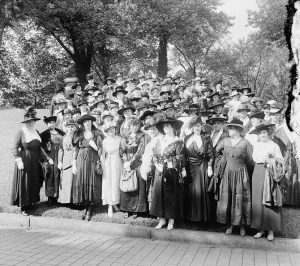Between 2 March 1907 and 22 September 1922, the Expatriation Act of 1907 required a woman who married a foreigner to take the nationality of her husband, and therefore she lost her own citizenship. The Cable Act (also known as the “Married Women’s Independent Nationality Act” or the “Married Women’s Act”) passed on 22 September 1922; it repealed the 1907 law and thus severed a woman’s marital status from her husband’s nationality. During the years between 1907 and 1922, an American-born woman who married an alien eligible for citizenship could still regain her own citizenship, but she had to go through the entire process of naturalization as if she were a newly arrived immigrant, and therefore had to provide witnesses for her character as well as take the Oath of Allegiance. Even after the Cable Act was enacted, a woman who was married to an alien and had lost her citizenship during the Expatriation Act still had to go through the full naturalization process.
It was an act in 1936 which allowed a woman who had lost her citizenship through marriage, a “marital expatriate,” to apply for repatriation provided that she was no longer married to her alien spouse – whether through death or divorce – by submitting her U.S. birth, marriage, and divorce records (or her husband’s death certificate), then taking an Oath of Allegiance. Most female repatriations took place after 1936. Then, on 2 July 1940, an act allowed all women who lost their citizenship by marriage to repatriate – regardless of their marital status. But they still had to take an oath of allegiance and swear that they had continually resided in the United States since their marriage.[i]
Women could repatriate at any District Court, and these repatriation applications are part of Record Group 21 and housed at the National Archives and Records Administration (NARA) branch that would hold records for that particular District Court’s location.
As an example of an exceptional circumstance, a woman who was born in Iowa in 1891 married a man from Lithuania in 1915; he died in 1941. Later, in 1965, she attempted to obtain a passport. Because she did not realize that she lost her citizenship, she had to repatriate in order to do so. Since she was applying for citizenship in 1965, current laws required that she had to have an Alien Registration Number. An “A-number” is a unique personal identifier assigned to a non-citizen, and an A-File became the official file for all immigration and naturalization records created or consolidated for every immigrant who arrived after 1 April 1944 or naturalized after 1 April 1956 (and for immigration law enforcement matters.)[ii]
“I lost … United States citizenship solely by reason by my marriage…”
My example’s A-File included the document “Application to Take Oath of Allegiance and Form Such Oath.” Because she did not have her birth record and could not obtain it, she had to submit a letter from the town registrar stating that the birth record did not exist. Instead, she submitted her baptismal and marriage records. She also had to complete the “Preliminary Form to Take Oath of Allegiance.”
A section of this document to fill out read: “I lost, or believe that I lost, United States citizenship solely by reason by my marriage on (date) to (spouse) then, an alien, a citizen or subject of (country of nativity) my marital status with such person was terminated.” Note, this example is not typical, but if the repatriation application is part of an A-File, this file may also include vital records, proof of residency, correspondence, and other documents that may not be available elsewhere.
The United States Citizenship and Immigration Service (USCIS) and NARA signed an agreement on 3 June 2009 to make the Alien Files a permanent series of records, transferred to NARA custody one hundred years after the immigrant’s year of birth. As of 1 August 2012, the National Archives at Kansas City had received more than 400,000 A-Files for individuals who were born in or before 1910.
A side note: my in-laws married in 1961 in Massachusetts, and my mother-in-law, born in Connecticut, went to change her voter registration to reflect her new surname. My father-in-law immigrated to the U.S. in the late 1950s and was not yet an American citizen at that point. A person from an older generation handling my mother-in-law’s registration at first told her that she might have lost her citizenship due to her marriage, but after checking with someone, told her that she hadn’t.
Sources:
- https://www.archives.gov/files/publications/prologue/2014/spring/citizenship.pdf
- Richard Simon, “Spotlighting a law that stripped U.S.-born women of citizenship: The Expatriation Act of 1907 required a woman who married a foreigner to ‘take the nationality of her husband.’ Daniel Swalm’s grandmother was one such woman, and he’s on a quest for justice,” Los Angeles Times, 19 April 2014.
- https://www.archives.gov/research/immigration/aliens
- https://www.archives.gov/research/immigration/aliens/a-files-kansas-city.html
- https://www.uscis.gov/history-and-genealogy/genealogy/certificate-series-numbers
- https://www.archives.gov/publications/prologue/1998/summer/women-and-naturalization-1.html
- “Women and Naturalization” lecture, Rhonda R. McClure, Senior Genealogist, New England Historic Genealogical Society
Notes
[i] https://www.archives.gov/files/publications/prologue/2014/spring/citizenship.pdf
[ii] https://www.uscis.gov/history-and-genealogy/genealogy/files-numbered-below-8-million#WhatAreAFiles
Share this:
About Nancy Bernard
Nancy holds a certificate from the Boston University Genealogical Research program. She has a master’s degree in history and media study from SUNY University of Buffalo, where she focused on American cultural history and writing and producing documentary videos. She also has a B.A. from Hamilton College. She has interned at the American Jewish Historical Society, now at NEHGS, as well as the National Heritage Museum in Lexington, MA. Her areas of interest include New England and New York history and researching house histories and the families who lived in those homes.View all posts by Nancy Bernard →
